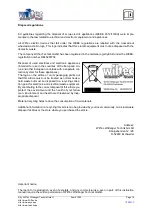
© by WilTec Wildanger Technik GmbH
Item 61055
Page 9
10 2021
-1
Starting and stopping the drywall sander
Make sure that the power circuit voltage is the same as shown on the specification plate on the sander,
and that the sander switch is OFF. Connect Sander to the power circuit. The drywall sander is equipped
with a rocker switch. The top end of the switch button is labelled OFF, and the bottom end of the button
is labelled ON. To start the sander, push the bottom end of the switch button (ON), to stop the sander,
push the top end of the switch button (OFF).
Sanding drywall
•
The drywall sander has a unique articulating sanding head: the abrasive pad, to conform to the
work surface.
•
This enables the operator to sand the top, middle and bottom of a wall or ceiling joint.
•
When sanding a tall wall or ceiling, please use a ladder for help.
•
The sanding pad is able to adjust the height by itself when it meets an uneven wall.
•
CAUTION:
Wear a respirator approved for dust and mist.
1. Turn the drywall sander switch ON.
2. Position the drywall sander lightly against the work surface (apply just enough pressure to align
the sanding head with the work surface).
3. Apply additional pressure to engage the abrasive pad to the work surface: while moving the
Sander in an overlapping pattern to smooth the drywall compound down to a “feather
-
edge.”
4. Keep the sander in constant motion while the abrasive pad is in contact with the work surface.
Use a steady sweeping motion. Stopping the sander (on the work), or moving it erratically can
cause unesthetic swirl marks and unevenness in the work surface.
•
NOTE:
Do not allow rotating abrasive pad to contact sharp protrusions. Contact with protruding
objects (nails, screws, electrical boxes, etc,), can severely damage the abrasive pad.
Maintenance
•
Keep tools clean. Always clean up debris and dust. Often add lubricating oil and grease (re-
ducer, bearing) to keep the tool flexible in operation.
•
Always check the power cable, the plug and the switches so that the tools remain in good con-
dition. Power tools produced by the company underlie a strict quality inspection. If the machine
still fails, please never repair the machine by yourself without authorization of the customer
service department.




























